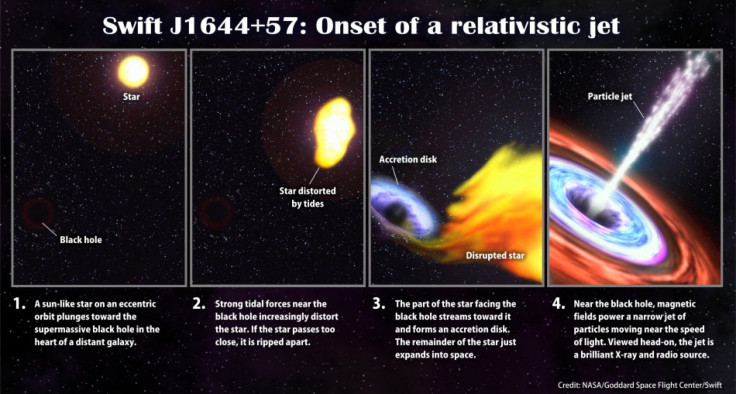NASA Astronomers Witness Super-sized Black Hole Swallowing Star (VIDEO)

NASA's Swift Satellite has captured an unusual cosmic phenomenon of the awakening of a distant, dormant massive black hole and the subsequent devouring of a sun-like star.
The details documented in the latest edition of the journal Nature mentions the appearance of intense and unusual high-energy flares from the new source in the constellation Draco.
Although, scientists and astronomers have seen such cosmic violence aftermaths previously, they have never actually seen one in the actually process.
This was the first time we saw one of these big black holes going from quiet and silent to very loud and noisy, producing a lot of light and radiation, the Los Angeles Times quoted study author Davide Lazzati from the North Carolina State University stating.
On March 28, NASA's Swift orbital telescope alert astronomers to intense and unusual high-energy flares in the constellation Draco, which has reportedly been streaming X-rays toward Earth. Scientists soon realized the source, known as Swift J1644 57, was actually the awakening of a distant galaxy's black hole and it consumed a star, which is so far away that it took light from the event approximately 3.9 billion years to reach Earth.
Incredibly, this source is still producing X-rays and may remain bright enough for Swift to observe into next year, said David Burrows, a professor of astronomy at Pennsylvania State University and lead scientist for the mission's X-Ray Telescope instrument. It behaves unlike anything we've seen before.
According to the new studies, the size of the black hole in the galaxy hosting Swift J1644+57 may be twice the mass of the four-million-solar-mass black hole in the center of the Milky Way galaxy.
As a star moves toward a black hole, it is ripped apart by the pressure, causing the gas to form into a disk that swirls around the black hole and become heated to extremely intense temperatures.
As the disk spirals toward the black hole it creates dual funnels through which some particles may escape, researchers said, adding that jets driving matter at velocities greater than 90 percent of the speed of light from around the black hole's spin axis. In this case, one of those jets happened to be pointing at Earth.
Although, the opportunity of witnessing a similar event is rare, scientists are still hopeful particularly after knowing what exactly to look for.
© Copyright IBTimes 2024. All rights reserved.





















